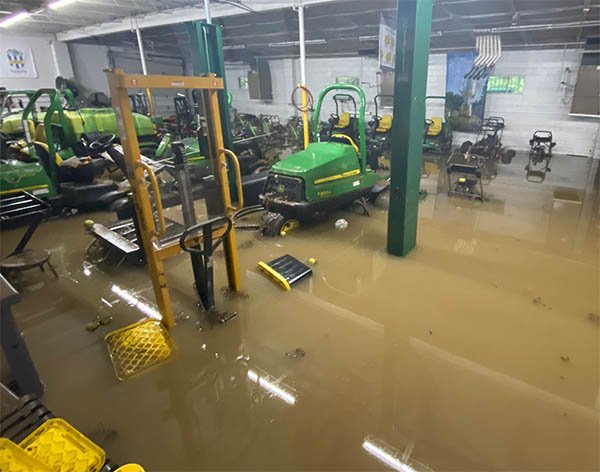
When a storm swept through Missouri in early August, it was something straight from a bad dream.
Two years removed from a major championship, Bellerive Country Club was coming off a two-step greens rebuild project when Mother Nature unleashed her wrath.
The front nine, rebuilt first, opened in the spring along with a few back nine holes that were ahead of schedule. The remaining back nine holes were opened to members on Aug. 7. The following day, up to 7 inches of rain dumped on parts of St. Louis, and it seemed like every inch was channeled Bellerive's way.
 Dubbed by meteorologists as a 500-year flood, the event transformed Smith Creek that bisects the property into a raging river that Carlos Arraya, CGCS, Bellerive's director of agronomy and assistant general manager, says left the maintenance facility and much of the golf course under 5 feet of water.
Dubbed by meteorologists as a 500-year flood, the event transformed Smith Creek that bisects the property into a raging river that Carlos Arraya, CGCS, Bellerive's director of agronomy and assistant general manager, says left the maintenance facility and much of the golf course under 5 feet of water.
An adjacent home where the club houses interns also was flooded. Three interns who had been staying there were able to get out safely and have been relocated to extended-stay facilities off site.
When the flood waters receded two days later, the golf course was covered in silt from the creek, bunkers were washed out and nearly all of the club's equipment was damaged, destroyed or washed away.
"We didn't even have a shovel or buckets to begin removing silt," Arraya said. "We had to make a run to Lowe's.
"I've endured hurricanes, including three back-to-back-to-back. When they were gone, you still had equipment. We don't have anything."
The only piece of mechanized equipment that was not affected was a front end loader parked at the sand pit awaiting aerification that was to begin the following Monday.
What has ensued has been an exercise in neighbor helping neighbor during a time of need and how to communicate up to keep members informed during a tragedy.
"I wiggle my way into the boardroom, I'll stay late or after work and I will speak to everyone I can," Arraya said. "I have to stay in front of them."
Indeed, golfers at Bellerive have endured a lot. First the front nine, then the back were closed for a greens rebuild last year. The year before, the course was the site of the 100th PGA Championship, and in 2016 and '17, parts of the course were closed as needed to protect greens during times of stress in advance of the tournament.
After the rebuild, nine holes, then 12 were opened in the spring. The remaining holes on the back nine were not scheduled to open until September. The opening was moved up to August 7 when the grow-in went better than expected. For a brief one-day period all 18 holes were open. It was the first time that had happened since last year's club championship.
"I feel so badly for them," Arraya said. "This is the fifth summer that they haven't had the golf course open totally unimpeded. It's been brutal."
A month later, the comeback continues. All mowing and spraying equipment has been rendered useless and the shop is off limits due to insurance issues.

A two-decade-old study by the Metropolitan St. Louis Sewer District showed that anywhere from 8 percent to 17 percent of rainwater in the surrounding neighborhood ran onto the golf course in 2000. Twenty years later, construction and more impervious surfaces are bringing even more water onto the property. Areas on the golf course that once were immune from flooding now lie in a 100-year floodplain - including Bellerive's maintenance facility.
"We have to build a new shop, but we have to move it," Arraya said. "We can't build it here. We have to get it out of the floodplain."
Erb Equipment, the local John Deere dealer, has helped out with mowing equipment, and Bill Maynard of MTI Distributing (Toro) has helped mow fairways with one of his company's units.
Arraya still lacks the equipment - and time - needed for fall applications, and he can't make any long-term decisions on a fleet until those insurance issues are resolved.
"Fall applications for weed suppression, pre-emergent fungicide applications, we can't do that. We don't have the equipment, and we're already behind," he said. "We have more nutsedge and Bermuda in low-lying areas where the water sat. Weed pressure is significant. Along the creek banks there are exotic weeds I haven't even identified yet."
Arraya and his team have concentrated their resources on short-mow areas. And members have been understanding of the challenges that lie ahead. The process, Arraya, said, is not unlike the phases of grief.
"When you see the devastation, you wonder 'why us?' " Arraya said. "The members have been great and asked right away 'what can we do to support you?' They are feeling anger, disappointment and now acceptance and moving forward. I don't think they understand the long-term implications. We have to lead them on that path."
Arraya has built a career defined by leadership, and that is why he has been on the fast track at Bellerive, elevating from superintendent to director of agronomy and now assistant general manager in three years.
"This is not all about growing grass," he said. "We are showcasing leadership.
"They definitely don't teach you this in school."

